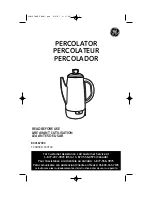
- 9 -
- 10 -
Washing all vacuum accessories in warm water with a mild dishwashing soap, but do
not immerse cover in water.
1. Canister bases (not lids) are top rack dishwasher safe. But canister cover should
be wiping down with a damp cloth.
2. Ensure the accessories to be dry thoroughly before reusing.
3. Canister and cover is not allowed to use in microwave or freezer.
CLEANING AND MAINTENANCE
FOOD PRESERVATION GUIDELINES
Note:
After finished the vacuum work, please always let the machine cover open,
don’t fasten the cover, it will deform the form gaskets and affect the machine
function.
Note:
The foam gaskets around the vacuum chamber should be dried thoroughly
before re-assembling, when re-assembling, is careful to prevent any damage,
and assemble as original position to ensure no vacuum leaking.
1. Wash bags in warm water with a mild dishwashing soap.
2. When wash bags in dishwasher, turn bags inside out and spread them over top
rack of dishwasher, so entire surface is exposed to the washing water.
3. Dry thoroughly before reusing.
longer when vacuum packed. Nuts and condiments maintain their flavor while
rancidity is kept out.
16. For objects with sharp points and edges, such as bones or dried pasta, pad the
edges with paper towels to keep them from puncturing the bag.
17. There are many non-food uses for vacuum packing. Keep camping supplies such
as matches, first aid kits and clothing, clean and dry. Keep flares for auto emergencies
ready. Keep silver and collectibles untarnished. 1. The main function of this appliance
is to store a wide kind of foods for freshness, longer, flavor and convenience. In
general, vacuum packaging keeps food fresh up to three times as long as other
traditional food storage methods. Once this appliance as an indispensable part of
your life, it will less food spoilage and save more money.
18. It’s ideal to prepackage ingredients as well as individual portions for the health-
conscious, such as weight-conscious or those on diets or nutritional regimes with
special requirements.
19. This system can also be used to store and protect other items: valuable items,
such as photos, important documents, stamp collections, book collections, jewellery,
cards, comics etc.; hardware items, such as screws, nails, studs and bolts;
medicines, band-aids and other first-aid items, etc..
1. Always unplug the unit before cleaning.
2. Do not immerse in water or any other liquid.
3. Avoid using abrasive products or material to clean the unit, for they will scratch the
surface.
4. Use a mild dishwashing soap and a warm, damp cloth to wipe away food residue
or around components.
5. Dry thoroughly before using again.
a). Cook in advance to vacuum seal and store individual portions or entire meals. This
vacuum bag is not recommended for microwave or boil-in-bag cooking, please use
the general cooking method to re-heat the vacuum-sealed foods.
b). Prepare foods in advance for picnics and camping trips or barbecues.
c). Eliminate freezer burn.
d). Package foods, such as meat, fish, poultry, seafood and vegetables to freeze or
refrigerate.
e). Package dry foods, such as beans, nuts, and cereals to store longer.
1. Vacuum sealer
3. Accessories
1. Keep the unit in a flat and safe place, out of the reach of children.
2. Do remember to make sure the lid of appliance is unlocked when not in use and in
storage. Keep the cover locked will distort the foam gaskets causing leaking.
Classification
Refrigerant
Frozen
Fresh Raw Meat
5±3
℃
2
~
3days
8
~
9days
4
~
5days
10
~
14days
7
~
10days
14
~
20days
30
~
50days
>
1yeas
>
1yeas
1
~
3days
4
~
6days
3
~
5days
5
~
7days
10
~
15days
3
~
5months
3
~
5months
5±3
℃
5±3
℃
5±3
℃
5±3
℃
5±3
℃
-
16
~-
20
℃
-
16
~-
20
℃
Fresh Fish/ Sea Food
Cooked Meat
Vegetables
Fruit
Eggs
Meat
Fish
Food Items
Temperature
Normal
Preservation
Vacuum
Preservation
Storing Your Vacuum Sealer:
2. Vacuum bags
IMPORTANT: To avoid possible illness, do not reuse bags after storing raw
meats, raw fish or greasy foods. Do not reuse bags that have been
microwaved or boiled.





















